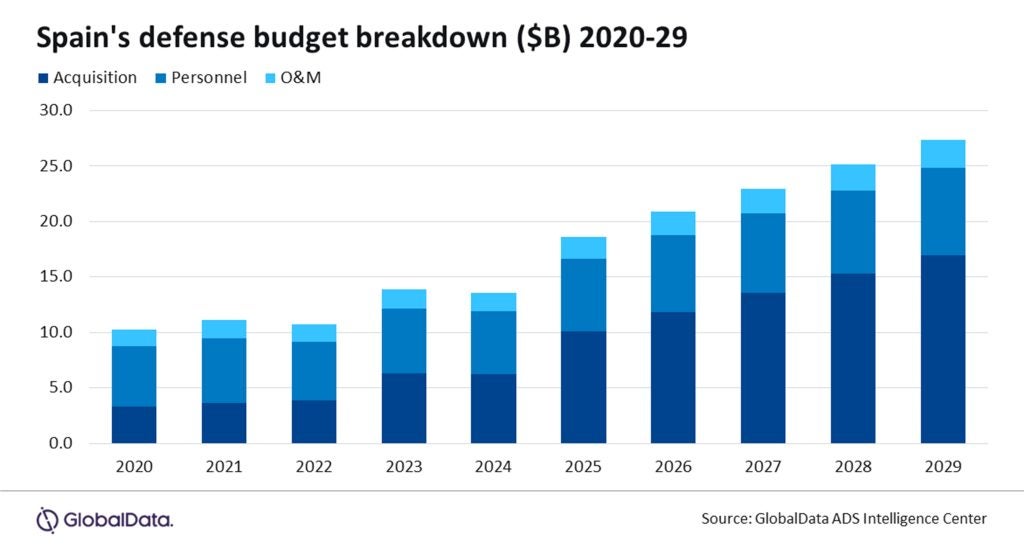
GlobalData’s “Spain Defense Market 2024-2029” report highlights an increase in Spain’s defence spending, which is projected to hit $27.3bn (€24.6bn) by 2029.
Despite political roadblocks, defence acquisitions provide economic benefits while ensuring Spain’s gradual alignment with Nato’s 2% defence spending goal.

Discover B2B Marketing That Performs
Combine business intelligence and editorial excellence to reach engaged professionals across 36 leading media platforms.
In its latest report, “Spain Defense Market 2024-2029”, GlobalData reveals that Spain’s defence budget is on a steady upward trajectory, expected to climb from $10.3bn in 2020 to $27.3bn by 2029. This increase will boost the country’s defence acquisitions and personnel spending despite political challenges that have delayed the country’s goal of reaching Nato’s 2% of GDP defence spending target by 2030.

According to the report, Spain’s defence budget, which stood at just 0.74% of GDP in 2020, is expected to rise to 1.54% by 2029. Although the country is unlikely to meet NATO’s 2% target before 2030, this growth reflects a shift in priorities, driven largely by increasing geopolitical tensions in Europe, particularly Russia’s invasion of Ukraine in 2022.
Political delays hamper immediate progress
While Spain’s defence spending has been on an upward trend since 2020, political gridlock has slowed progress. In 2023, Spain experienced a close and highly contested general election, leading to a temporary government under Prime Minister Pedro Sanchez in November. During the months-long government formation process, defence budget approvals were stalled, forcing Spain to repeat its 2023 budget for the 2024 fiscal year.
Wilson Jones, Defence Analyst at GlobalData, comments, “The country’s most recent general election occurred in July 2023 and was extremely close, resulting in a temporary pause on defence spending increases.”

US Tariffs are shifting - will you react or anticipate?
Don’t let policy changes catch you off guard. Stay proactive with real-time data and expert analysis.
By GlobalDataDespite the expected rise in acquisitions, with the budget for defence procurement rising from $3.3bn in 2020 to $17bn by 2029, other areas, such as operations and maintenance (O&M), need to catch up. O&M spending will grow modestly to $2.4bn, potentially undermining Spain’s military readiness and operational effectiveness.
Major acquisitions signal ambitions
One of the GlobalData report’s findings is the growth in defence acquisitions. Spain’s acquisition budget, set to increase by over 400% by 2029, will enable it to invest in new platforms that bolster its defence capabilities.
Despite mounting global security concerns, this investment comes as Nato allies push for greater defence contributions. Jones notes that “These programmes not only expand Spain’s power projection and ensure spending increases, but also provide a boon to the economy and retain skilled jobs in Spain.”
Challenges in personnel and maintenance
Despite the rise in acquisitions, the report cautions that other areas of Spain’s defence budget, particularly personnel and O&M spending, are not keeping pace. Personnel spending is projected to grow moderately, from $5.7bn in 2024 to $7.8bn by 2029, leaving concerns about adequate staffing and training for the new platforms.
Jones stresses, “Although spending on new platforms is high, it is also essential to train and prepare crews in their operation, especially under adverse conditions.”
Outlook: Slow but steady progress
While Spain’s political divisions have created short-term hurdles, the long-term trajectory for defence spending remains optimistic.
GlobalData’s report concludes that by barring further political delays, Spain will be on track to meet its defence spending targets by the early 2030s.
Spain’s defence budget is poised for growth, driven by geopolitical imperatives and a renewed commitment to Nato. While political challenges remain, the defence sector benefits from the country’s steady progress toward the 2% GDP spending target.





